Arctic Sea Ice Surface Temperature Inversion Using FY-3D/MWRI Brightness Temperature Data
Abstract
1. Introduction
2. Materials and Methods
2.1. Datasets
2.1.1. FY-3D/MWRI Data
2.1.2. Aqua/MODIS Data
2.1.3. Northern High Latitude L3 Sea and Sea Ice Surface Temperature Data
2.1.4. Operation IceBridge KT19 IR Surface Temperature Data
2.2. Methods
2.2.1. Data Preprocessing
2.2.2. Multivariate Statistical Regression Algorithm
3. Results
3.1. Multivariate Statistical Regression Results
3.2. Ice Surface Temperature Inversion Results
4. Discussion
4.1. Comparative Statistical Analysis with NHL L3 IST Data
4.2. Comparative Statistical Analysis with OIB KT19 IR IST Data
5. Conclusions
Author Contributions
Funding
Data Availability Statement
Acknowledgments
Conflicts of Interest
References
- Hall, D.K.; Key, J.R.; Casey, K.A.; Riggs, G.; Cavalieri, D. Sea Ice Surface Temperature Product from MODIS. IEEE Trans. Geosci. Remote Sens. 2004, 42, 1076–1087. [Google Scholar] [CrossRef]
- Zhou, Y.; Kuang, D.; Gong, C.; Hu, Y.; Fang, S.; Zhang, Y.; Peng, Y. A method to extract parameters of Arctic sea ice from FY-3/MERSI imagery. J. Infrared Millim. Waves 2017, 36, 41–49. [Google Scholar]
- Kilic, L.; Tonboe, R.; Prigent, C.; Heygster, G. Estimating the snow depth, the snow-ice interface temperature, and the effective temperature of Arctic sea ice using Advanced Microwave Scanning Radiometer 2 and Ice Mass Balance buoys data. Cryosph. Discuss. 2019, 13, 1283–1296. [Google Scholar] [CrossRef]
- Xi, M. Merging Infrared Radiometer and Microwave Radiometer Sea Surface Temperature Data Based on the Optimum Interpolation. Master’s Thesis, National Marine Environmental Forecasting Center, Physical Oceanography, Beijing, China, 2011. [Google Scholar]
- Guan, L.; Zhang, H.; Qu, L.Q. Sea Surface Temperature Merged from MultiSensor Data; Proc. 2005 Dragon Symposium “Mid-Term Results”, Santorini, Greece, 27 June–1 July 2005; European Space Agency SP-611: Paris, France, 2006. [Google Scholar]
- Key, J.R.; James, M.; Konrad, S. Ice Surface Temperature Retrieval from AVHRR, ATSR, and Passive Microwave Satellite Data: Algorithm Development and Application; Environmental Sciences University of Colorado: Boulder, CO, USA, 1995. [Google Scholar]
- Comiso, J.C.; Zwally, H.J. Temperature corrected bootstrap algorithm, in IGARSS’97. In Proceedings of the 1997 IEEE International Geoscience and Remote Sensing Symposium Proceedings. Remote Sensing—A Scientific Vision for Sustainable Development, Singapore, 3–6 August 1997; pp. 857–861. [Google Scholar]
- Comiso, J.C. SSM/I Sea Ice Concentrations Using the Bootstrap Algorithm; National Aeronautics and Space Administration, Goddard Space Flight Center: Greenbelt, MD, USA, 1995; p. 1380. [Google Scholar]
- Wentz, F.J.; Meissner, T. AMSR Ocean Algorithm Theoretical Basis Document, Version 2; Remote Sensing Systems: Santa Rosa, CA, USA, 2000. [Google Scholar]
- Li, L.; Guan, L.; Chen, H. Study on an Algorithm for the Retrieval of Oceanic and Atmospheric Parameters from Satellite Microwave Radiometer Measurements. Period. Ocean Univ. China 2006, 36, 205–211. [Google Scholar]
- Wentz, F.J.; Meissner, T. Supplement 1 Algorithm Theoretical Basis Document for AMSR-E Ocean Algorithms; RSS Technical Rpt. 051707; NASA: Santa Rosa, CA, USA, 2007.
- Holmes, T.R.H.; De Jeu, R.A.M.; Owe, M.; Dolman, A.J. Land surface temperature from Ka band (37 GHz) passive microwave observations. J. Geophys. Res. 2009, 114, D04113. [Google Scholar] [CrossRef]
- Scott, K.A.; Li, E.; Wong, A. Sea Ice Surface Temperature Estimation Using MODIS and AMSR-E Data Within a Guided Variational Model Along the Labrador Coast. IEEE J. Sel. Top. Appl. Earth Obs. Remote Sens. 2014, 7, 3685–3694. [Google Scholar] [CrossRef]
- Lee, S.-M.; Sohn, B.J. Retrieving the refractive index, emissivity, and surface temperature of polar sea ice from 6.9 GHz microwave measurements: A theoretical development. J. Geophys. Res. Atmos. 2015, 120, 2293–2305. [Google Scholar] [CrossRef]
- Sohn, B.J.; Lee, S.M. Analytical relationship between polarized reflectivities on the specular surface. Int. J. Remote Sens. 2013, 34, 2368–2374. [Google Scholar] [CrossRef]
- Lee, S.-M.; Sohn, B.J.; Christian, D.K. Long-Term Arctic Snow/Ice Interface Temperature from Special Sensor for Microwave Imager Measurements. Remote Sens. 2018, 10, 1795. [Google Scholar] [CrossRef]
- Chen, H.; Meng, X.; Li, L.; Ni, K. Quality Assessment of FY-3D/MERSI-II Thermal Infrared Brightness Temperature Data from the Arctic Region: Application to Ice Surface Temperature Inversion. Remote Sens. 2022, 14, 6392. [Google Scholar] [CrossRef]
- Key, J.R.; Collins, J.B.; Fowler, C.; Stone, R.S. High-latitude Surface Temperature Estimates from Thermal Satellite Data. Remote Sens. Environ. 1997, 61, 302–309. [Google Scholar] [CrossRef]
- Key, J.R.; Mahoney, R.; Liu, Y.; Romanov, P.; Tschudi, M.; Appel, I.; Maslanik, J.; Baldwin, D.; Wang, X.; Meade, P. Snow and ice products from Suomi NPP VIIRS. J. Geophys. Res. Atmos. 2013, 118, 12816–12830. [Google Scholar] [CrossRef]
- Nielsen-Englyst, P.; Høyer, J.L.; Kolbe, W.M.; Dybkjær, G.; Lavergne, T.; Tonboe, R.T.; Karagali, I. A combined sea and sea-ice surface temperature climate dataset of the Arctic, 1982–2021. Remote Sens. Environ. 2022, 284, 113331. [Google Scholar] [CrossRef]
- Jacob, L.H.; Ioanna, K.; Pia, N. Quality Information Document for Arctic Sea and Ice Surface Temperature Product, Copernicus Marine Environment Monitoring Service; DMI: Danish Meteorological Institute: Copenhagen, Denmark, 2021. (In Danish) [Google Scholar]
- Steinar, E.; Anette, L.B.; Atle, S. Validation Report for the Northern High Latitude L3 VIIRS Sea and Sea Ice Surface Temperature Product, OSI-203-b, Version 2.1. 2019. Available online: https://osisaf-hl.met.no/sites/osisaf-hl.met.no/files/validation_reports/osisaf_cdop3_ss2_valrep_nhl-l3-sst-ist_v2p+1.pdf (accessed on 10 April 2023).
- Hao, H.R.; Su, J.; Shi, Q.; Li, L.L. Arctic sea ice concentration retrieval using the DT-ASI algorithm based on FY-3B/MWRI data. Acta Oceanol. Sin. 2021, 40, 176–188. [Google Scholar] [CrossRef]
- Hall, D.K.; Riggs, G.A. MODIS/Terra Sea Ice Extent 5-Min L2 Swath 1 Km, Version 61. 90°N, −180°E; 60°N, 180°W, Credits; NASA National Snow and Ice Data Center Distributed Active Archive Center: Boulder, CO, USA, 2021. [Google Scholar] [CrossRef]
- Wu, S.L. FY-3D (02) Meteorological Satellite Ground Application System Engineering Microwave Radiation Imager Data Use Guide, Version 2.1, National Satellite Meteorological Center. 2019. Available online: https://img.nsmc.org.cn/PORTAL/NSMC/DATASERVICE/OperatingGuide/FY3D/FY3D_MWRI%e6%95%b0%e6%8d%ae%e4%bd%bf%e7%94%a8%e6%8c%87%e5%8d%97.pdf (accessed on 6 July 2022).
- OSI SAF Northern High Latitude L3 Sea and Sea Ice Surface Temperature (NPP) 2019-Onwards, OSI-203-b. EUMETSAT Ocean and Sea Ice Satellite Application Facility. Data Extracted from 25 January 2019 to 31 December 2019. North of 60N. Available online: https://osi-saf.eumetsat.int/products/osi-203-b (accessed on 10 April 2023).
- Studinger, M. IceBridge KT19 IR Surface Temperature, Version 2. Boulder, Colorado USA. NASA National Snow and Ice Data Center Distributed Active Archive Center. 2020. Available online: https://nsidc.org/data/iakst1b/versions/2 (accessed on 20 October 2022).
- Yang, H.; Wend, F.Z.; Lv, L.Q.; Lu, N.; Liu, G.; Bai, M.; Qian, Q.; He, J.; Xu, H. The FengYun-3 microwave radiation imager on-orbit verification. IEEE Trans. Geosci. Remote Sens. 2011, 49, 4552–4560. [Google Scholar] [CrossRef]
- Hall, D.K.; Riggs, G.A. MODIS/Aqua Sea Ice Extent 5-Min L2 Swath 1 Km, Version 6. 2015. Available online: https://nsidc.org/sites/default/files/myd29-v006-userguide_1.pdf (accessed on 6 March 2022).
- Barnes, W.L.; Xiong, X.; Salomonson, V.V. Status of Terra MODIS and Aqua MODIS. IEEE Int. Geosci. Remote Sens. Symp. 2002, 2, 970–972. [Google Scholar] [CrossRef]
- Hall, D.K.; Riggs, G.A.; Salomonson, V.V. MODIS Sea Ice Products User Guide to Collection 5. Available online: https://modis-snow-ice.gsfc.nasa.gov/uploads/siug_c5.pdf (accessed on 22 February 2022).
- Zhang, M.; Wang, S.J.; Qin, D.Y.; Qiu, H.; Tang, S.H. The inversion and quality validation of FY-3C MWRI sea surface temperature. J. Remote Sens. 2018, 22, 713–722. [Google Scholar] [CrossRef]
- Mathew, N.; Heygster, G.; Melsheimer, C. Surface Emissivity of the Arctic Sea Ice at AMSR-E Frequencies. IEEE Trans. Geosci. Remote Sens. 2009, 47, 4115–4124. [Google Scholar] [CrossRef]
- Comiso, J.C. Sea ice effective microwave emissivities from satellite passive microwave and infrared observations. J. Geophys. Res. 1983, 88, 7686–7704. [Google Scholar] [CrossRef]
- Shibata, A.; Imaoka, K.; Kachi, M.; Fujimoto, Y.; Mutoh, T. AMSR/AMSR-E sea surface temperature algorithm development, IGARSS 2003. In Proceedings of the 2003 IEEE International Geoscience and Remote Sensing Symposium, Toulouse, France, 21–25 July 2003; Volume 1, pp. 672–673, Proceedings (IEEE Cat. No. 03CH37477). [Google Scholar] [CrossRef]
- Yin, X.B.; Wang, Z.; Liu, Y.; Cheng, Y.; Gu, Y.; Fan, W. Comparison between Infrared and Microwave Radiometers for Retrieving the Sea Surface Temperature. Mar. Sci. Bull. 2007, 26, 3–10. [Google Scholar]
- Yan, H.; Li, X.Q.; You, Y.; Wu, S.L. Environmental Data Records from FengYun-3B Microwave Radiation Imager. Adv. Met. ST 2013, 3, 136–143. [Google Scholar]
- Mao, K.B.; Shi, J.; Li, Z.; Qin, Z.; Jia, Y. The Land Surface Temperature and Emissivity Retrieved from the AMSR Passive Microwave Data. Remote Sens. Land Resour. 2005, 3, 14–17+99. [Google Scholar]
- Worby, A.P.; Comiso, J.C. Studies of the Antarctic Sea Ice Edge and Ice Extent from Satellite and Ship Observations. Int. J. Remote Sens. 2004, 92, 98–111. [Google Scholar] [CrossRef]

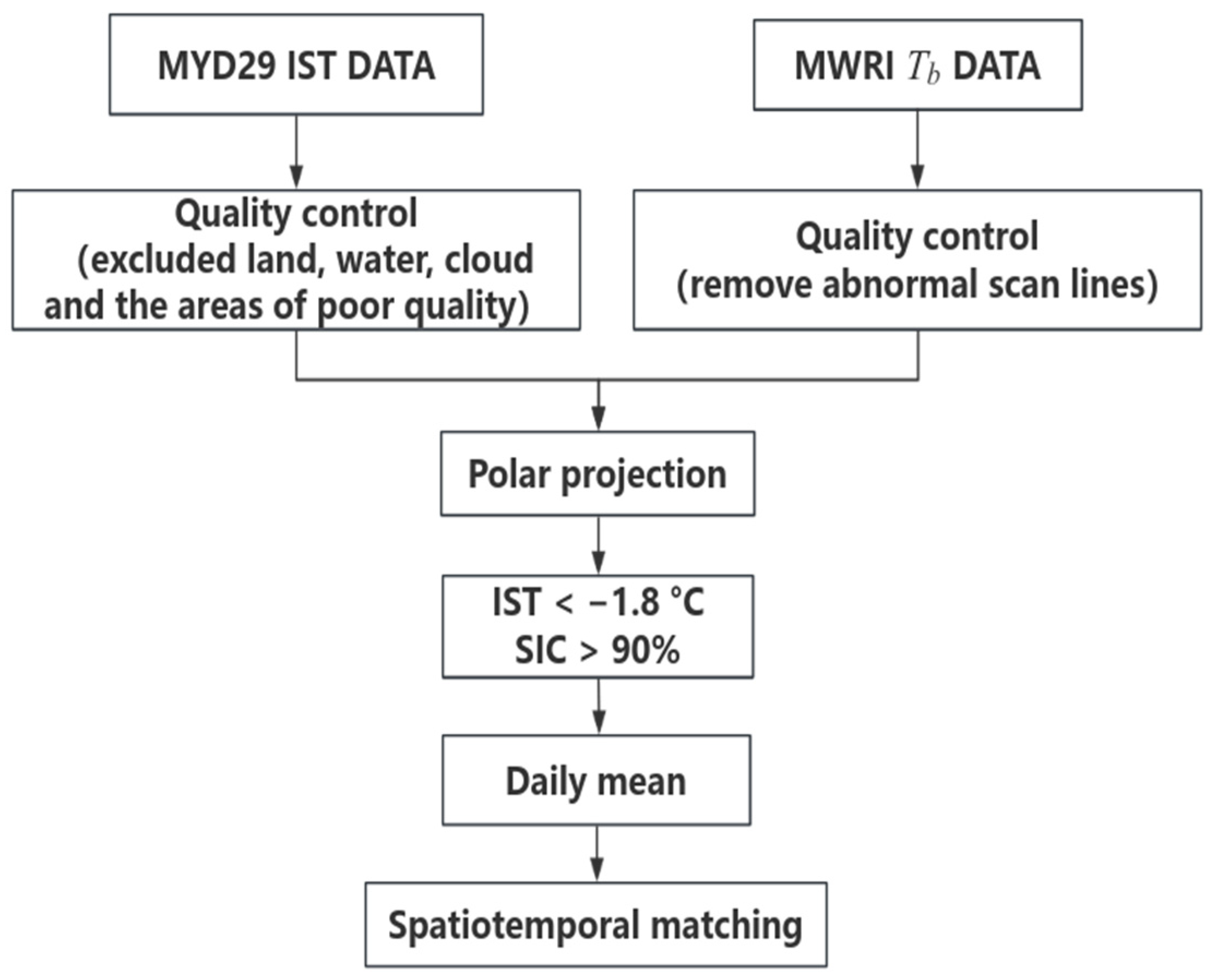

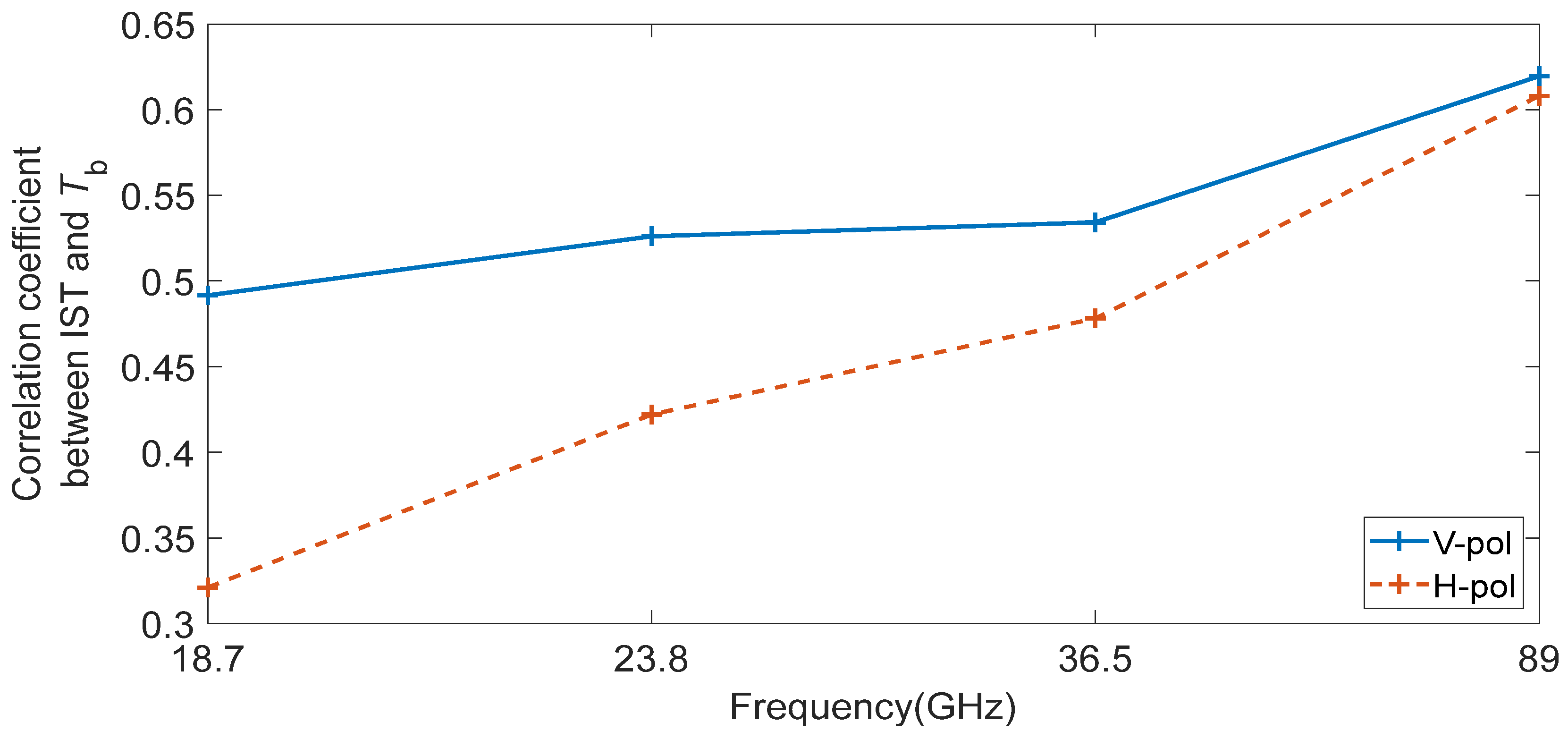
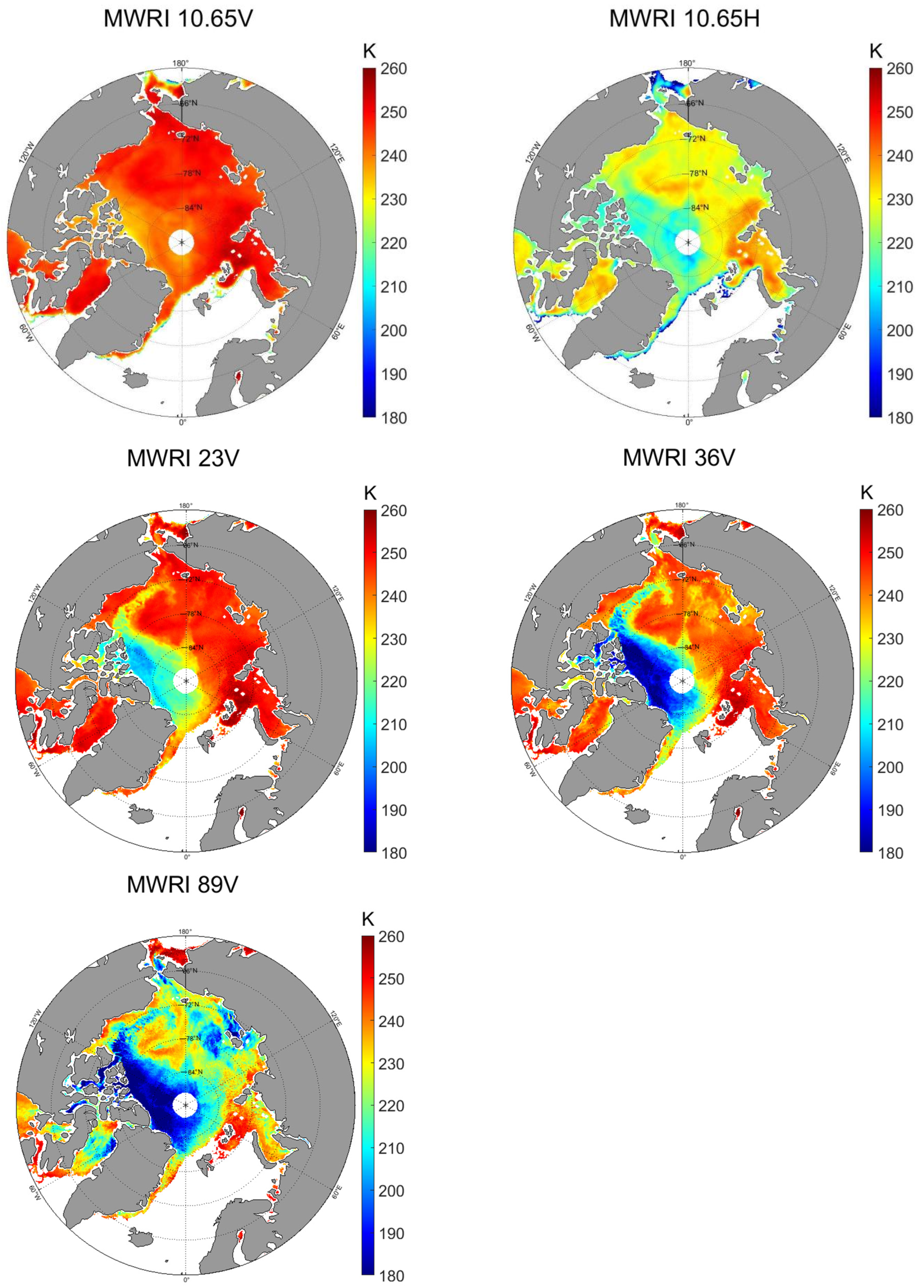
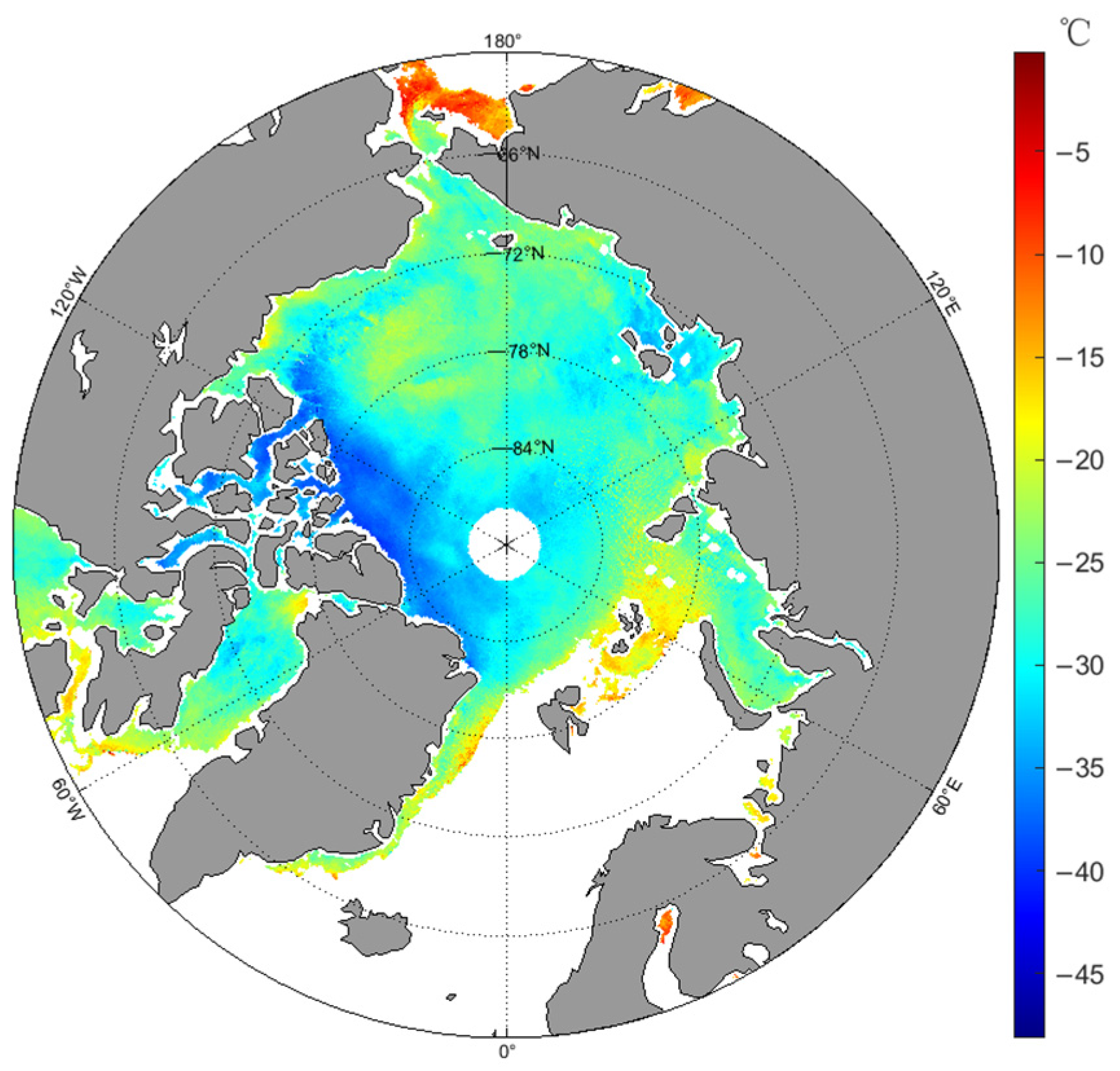

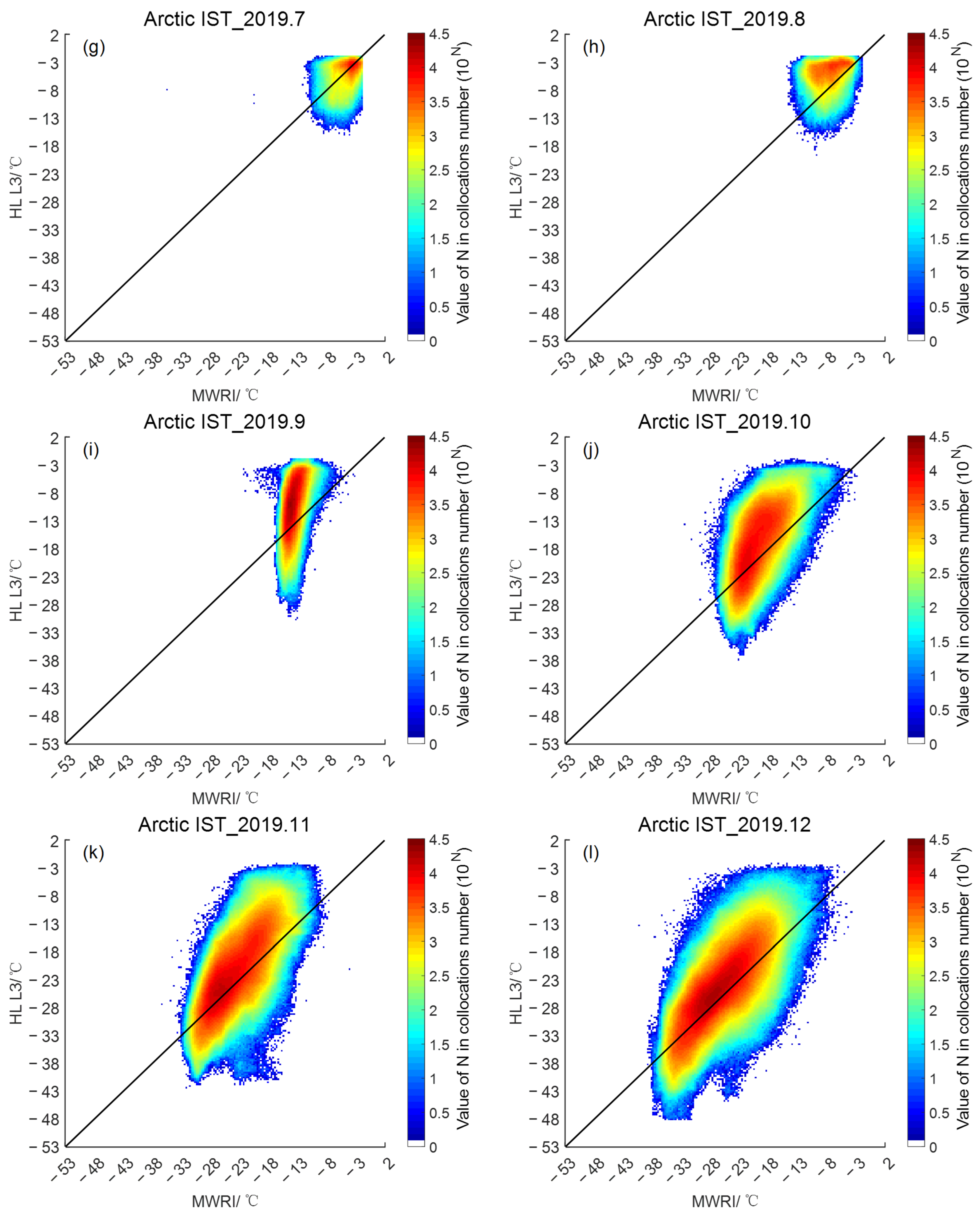
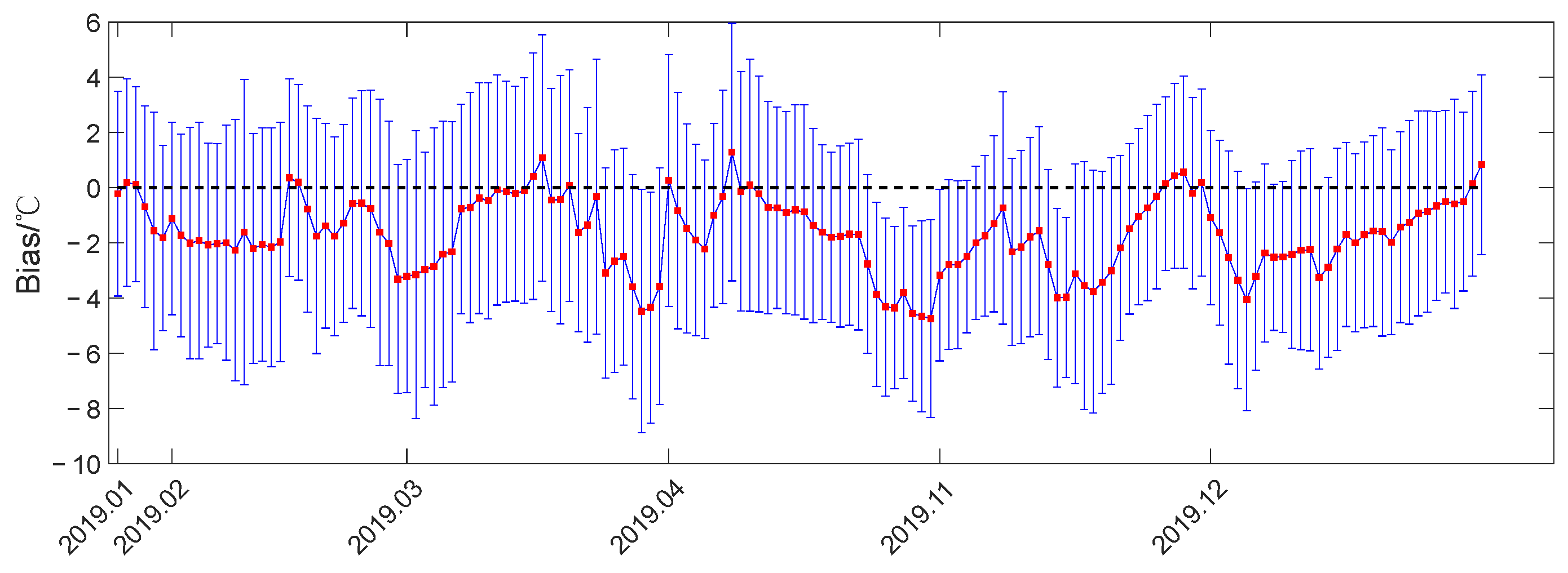
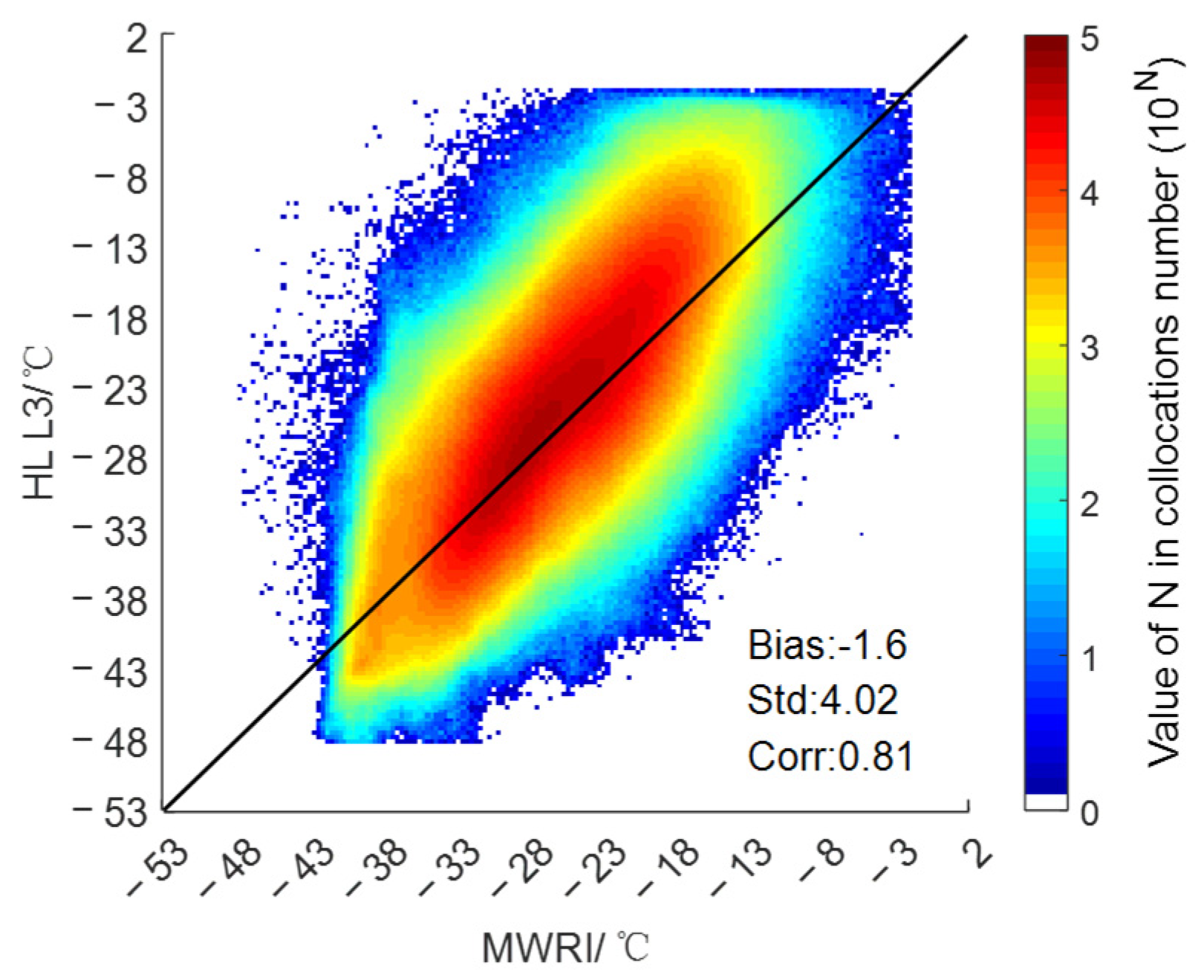
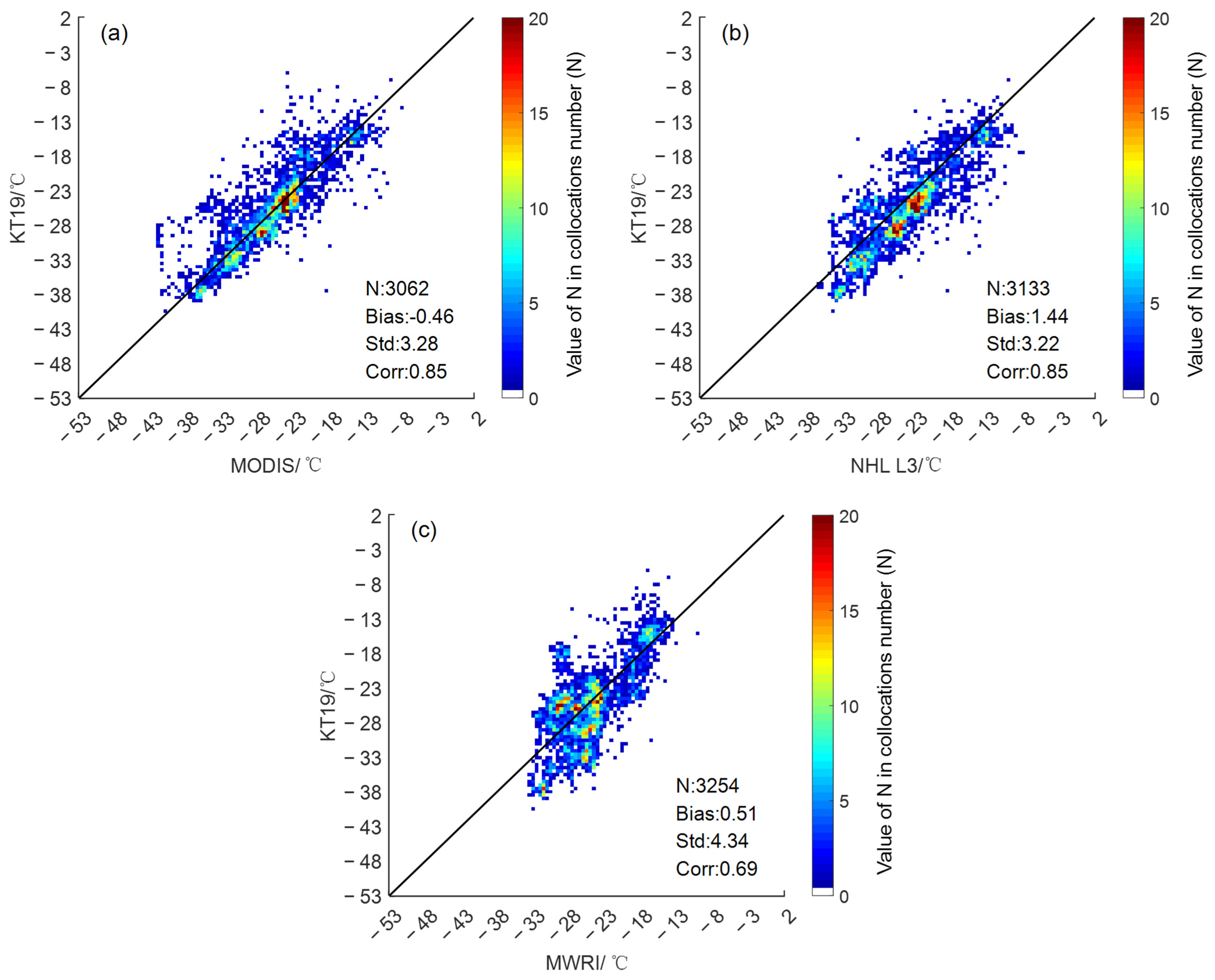
| Source | Satellite/Sensor | Datasets | Parameters | Spatial Resolution | Time Resolution |
|---|---|---|---|---|---|
| China National Satellite Meteorological Center | FY-3D/MWRI | L1C | Brightness Temperature | 50 min | |
| SIC | Sea ice concentration | 12.5 km | 1 day | ||
| NASA LAADS DAAC | Aqua/MODIS | MYD29 | Sea ice surface Temperature | 1 km | 5 min |
| MYD03 | Latitude and longitude | 1 km | 5 min | ||
| Ocean and Sea Ice Satellite Application Facilit | NPP/VIIRS | NHL L3 | Sea ice surface Temperature | 5 km | 12 h |
| Operation IceBridge | KT19 IR | Sea ice surface Temperature | 15 m |
| Sensor | MWRI | ||||
|---|---|---|---|---|---|
| Frequency (GHz) | 10.65 | 18.7 | 23.8 | 36.5 | 89 |
| Spatial Resolution (km × km) | 51 × 85 | 30 × 50 | 27 × 45 | 18 × 30 | 9 × 15 |
| Bandwidth (MHz) | 180 | 200 | 400 | 900 | 2 × 2300 |
| Sensitivity (K) | 0.5 | 0.5 | 0.5 | 0.5 | 0.8 |
| Satellite | FY-3D | ||||
| Polarization | V/H | ||||
| Breadth (km) | ≥1400 | ||||
| Dynamic range (k) | 3~340 | ||||
| Threshold, Buoy/K | Target, Buoy/K | Optimal, Buoy/K | |||
|---|---|---|---|---|---|
| Std | Bias | Std | Bias | Std | Bias |
| 4.0 | 4.5 | 3.0 | 3.5 | 1.0 | 0.8 |
| Jan. | Feb. | Mar. | Apr. | May | Jun. | Jul. | Aug. | Sep. | Oct. | Nov. | Dec. | |
|---|---|---|---|---|---|---|---|---|---|---|---|---|
| R2 | 0.64 | 0.57 | 0.60 | 0.45 | 0.09 | 0.05 | 0.15 | 0.14 | 0.04 | 0.31 | 0.49 | 0.59 |
| Matching Points | |||||||
|---|---|---|---|---|---|---|---|
| January | 15,721,685 | 396.1996 | 0.0614 | −0.2483 | −37.7362 | 26.5734 | −16.9252 |
| February | 14,923,734 | 353.6688 | 0.2722 | −0.2969 | −37.9461 | 31.6104 | −21.1286 |
| March | 16,217,105 | 468.9688 | −0.1132 | −0.2231 | −61.2745 | 46.4874 | −22.4522 |
| April | 14,535,996 | 285.9194 | 0.5516 | −0.4233 | −31.2029 | 23.4979 | −11.8030 |
| May | 8,952,292 | 294.1214 | 0.0949 | −0.1455 | −18.7054 | 13.8825 | −1.8806 |
| June | 4,771,335 | 285.2614 | −0.2027 | 0.1251 | 0.3523 | 0.0840 | 0.6738 |
| July | 2,283,151 | 227.7420 | −0.0722 | 0.1381 | 7.7663 | −0.9421 | 0.8756 |
| August | 2,101,423 | 288.8125 | −0.1246 | 0.1001 | −8.3691 | 0.3255 | 4.3951 |
| September | 4,596,585 | 318.4204 | −0.1239 | −0.0080 | −21.1507 | 16.8736 | −3.1576 |
| October | 7,192,761 | 339.4120 | 0.0474 | −0.1381 | −34.8020 | 30.7586 | −13.5859 |
| November | 11,611,805 | 329.9468 | 0.1754 | −0.2368 | −27.3781 | 20.7148 | −11.7784 |
| December | 15,074,632 | 307.4738 | 0.423 | −0.3608 | −25.833 | 18.3021 | −13.7578 |
| Std (°C) | Bias (°C) | Corr | |
|---|---|---|---|
| Jan. | 3.81 | −0.67 | 0.85 |
| Feb. | 4.18 | −1.55 | 0.75 |
| Mar. | 4.54 | −1.49 | 0.78 |
| Apr. | 3.96 | −1.67 | 0.72 |
| May | 3.49 | −1.38 | 0.35 |
| Jun. | 1.96 | −0.74 | 0.17 |
| Jul. | 2.06 | 0.31 | 0.4 |
| Aug. | 2.45 | −2.61 | 0.27 |
| Sep. | 3.43 | −3.52 | 0.51 |
| Oct. | 3.91 | −2.67 | 0.67 |
| Nov. | 3.75 | −1.82 | 0.76 |
| Dec. | 3.61 | −1.74 | 0.78 |
Disclaimer/Publisher’s Note: The statements, opinions and data contained in all publications are solely those of the individual author(s) and contributor(s) and not of MDPI and/or the editor(s). MDPI and/or the editor(s) disclaim responsibility for any injury to people or property resulting from any ideas, methods, instructions or products referred to in the content. |
© 2024 by the authors. Licensee MDPI, Basel, Switzerland. This article is an open access article distributed under the terms and conditions of the Creative Commons Attribution (CC BY) license (https://creativecommons.org/licenses/by/4.0/).
Share and Cite
Meng, X.; Chen, H.; Liu, J.; Ni, K.; Li, L. Arctic Sea Ice Surface Temperature Inversion Using FY-3D/MWRI Brightness Temperature Data. Remote Sens. 2024, 16, 490. https://doi.org/10.3390/rs16030490
Meng X, Chen H, Liu J, Ni K, Li L. Arctic Sea Ice Surface Temperature Inversion Using FY-3D/MWRI Brightness Temperature Data. Remote Sensing. 2024; 16(3):490. https://doi.org/10.3390/rs16030490
Chicago/Turabian StyleMeng, Xin, Haihua Chen, Jun Liu, Kun Ni, and Lele Li. 2024. "Arctic Sea Ice Surface Temperature Inversion Using FY-3D/MWRI Brightness Temperature Data" Remote Sensing 16, no. 3: 490. https://doi.org/10.3390/rs16030490
APA StyleMeng, X., Chen, H., Liu, J., Ni, K., & Li, L. (2024). Arctic Sea Ice Surface Temperature Inversion Using FY-3D/MWRI Brightness Temperature Data. Remote Sensing, 16(3), 490. https://doi.org/10.3390/rs16030490






